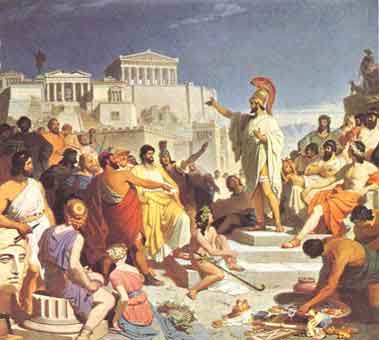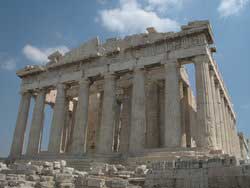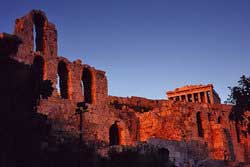|
|
The Age of Pericles is the term used to define the historical period from the capture of Samos by the Athenians (439 BC) to the defeat of the Greeks at the Battle of Chaeronea (338 BC) at the hands of the Macedonian army under Philip II of Macedon. Pericles - an Athenian general, politician and orator - distinguished himself above the other shining personalities of the era, men who excelled in politics, philosophy, architecture, sculpture, history and literature. He fostered arts and literature and gave to Athens a splendor which would never return throughout its history. He executed a large number of public works projects and improved the life of the citizens. Hence, this important figure gave his name to the Athenian Golden Age, the zenith of classical Greece.
Government A 20 drachma Greek coin with the image of a temple on the obverse and the effigy of Pericles on the reverse (1982) During this century, Athens was governed by 10 strategoi (or generals) who were elected each year by the 10 clans of citizens. These strategoi had duties which included planning military expeditions, receiving envoys of other states and directing political affairs. During the time of the ascendancy of Ephialtes as leader of the democratic faction, Pericles was his deputy. When Ephialtes was assassinated by personal enemies, Pericles stepped in and was elected strategos in 445 BC, a post he held continuously until his death in 429 BCE, always by election of the Athenian Assembly. Pericles was a great orator; this quality brought him great success in the Assembly, presenting his vision of politics. One of his best moves was to allow thetes (Athenians without wealth) to occupy public office. Another success of his administration was the creation of the misthoforia (μισθoφoρια, which literally means paid function), a special salary for the citizens that attended the Assembly. This way, these citizens were able to completely dedicate themselves to public service without facing financial hardship. With this system, Pericles succeeded in keeping the Assembly full of members. As Athens' ruler, he made the city the first and most important polis of the Greek world, acquiring a resplendant culture and democratic institutions. The sovereign people governed themselves, without intermediaries, deciding the matters of state in the Assembly. The Athenian citizens were free and only owed obedience to their laws and respect to their gods. They achieved equality of speech in the Assembly: the word of a poor person was the same worth as that of a rich person. The censorial classes did not disappear, but their power was more limited; they shared the fiscal and military offices but they did not have the power of distributing privileges. The principal of equality granted to all citizens had the danger of constituting a fraud, since many of them were incapable of exercising the political rights, due to their extreme poverty or their ignorance. To avoid this, the Athenian democracy applied itself to the task of helping the most poor in this manner: Concession of salaries for public functionaries. These norms should have been carried out in great measure since the testimony has come to us (among others) from the Greek historian Thucydides (c. 460 - 400 BC), who comments: Everyone who is capable of serving the city meets no impediment, neither poverty, nor civic condition...
Institutions The magistrates The magistrates were people who occupied a public post and formed the administration of the Athenian state. They were submitted to a rigorous public control. The magistrates were chosen by lot, using fava beans. Some black and white beans were put in a box and depending on which color the person drew out they obtained the post or not. This was a way of eliminating all personal influence of rich people and possible intrigues and use of favors. There were only two categories of posts which were chosen not by lot, but by election in the Popular Assembly, that of strategos, or general, and that of magistrate of finance. It was generally supposed that significant qualities were needed to exercise each of those two offices. A magistrate's post did not last more than a year, including that of the strategoi and in this sense the continued selection of Pericles year after year was an exception. At the end of every year, a magistrate would have to give an account of his administration and use of public finances. The most honored posts were the ancient archontes, or archons in English. In previous ages they had been the heads of the Athenian state, but in the Age of Pericles they lost their large influence and power. Although they still presided over tribunals. The strategoi (generals) were the most important office holders in their capacity as army and navy officers and as diplomats. The Assembly elected 10 every year. There were also more than 40 officials of the (hacienda) state and more than 60 to police the streets, the markets, to check weights and measures and to carry out arrests and executions.
The Assembly of the People The Assembly (in Greek, εκκλησια, that is to say, an assembly by summons), was the first organ of the democracy. In theory it intended to bring together in assembly all the citizens of Athens, but the maximum number which came to congregate is estimated at 6,000 participants. The gathering place was a space situated on the hill called Pnyx, in front of the Acropolis. The sessions sometimes lasted at from dawn to dusk. They gathered forty times a year. The Assembly decided on the laws and the decrees which were proposed but relying always on the ancient laws which had long been in force. Bills were voted in two stages: first the Assembly itself decided and afterwards the Council or βουλη gave definitive approval.
The Council or Boule The Council or Boule (βουλη) consisted of 500 members, 50 from each tribe. These were chosen by chance, by the system described earlier, from which they were familiarly known as "councillors of the bean"; officially they were known as prytanes (πρυτανις, meaning "chief" or "teacher"). The council members examined and studied legal projects and, moreover, looked over the magistrates and saw that the daily administrative details were on the right path; similarly, they oversaw the city state's external affairs. This council was like a prolongation of the Assembly. They also met at Pnyx hill, in a place expressly prepared for the event. The 50 prytanes en ejercicio were located on grandstands carved into the rock. They had stone platforms which they reached by means of a small staircase of three steps. On the first plataform were the secretaries and scibes; the orator would climb up to the second.
Finances Reproduction of an Athenian tetradrachma with the efigie de Pallas Athena —protector of the city— on the front and an owl —symbol of wisdom— on the back (circa 490 BC) The economical resources of the Athenian State were not excessive. All of the glory of Athens in the Age of Pericles, its constructions, public works, religious buildings, sculptures, etc. would not have been possible without the treasury of the Delian League. Other small incomes came from customs rights and fines. In times of war a special tax was added to the rich citizens. These citizens were also charged permanently with other taxes which benefited the city. This was called the system of liturgy. The taxes were used to maintain the triremes which gave Athens great naval power and also to pay and maintain a chorus for big religious festivals.
Athenians in the Age of Pericles The Parthenon of Athens The Athenians lived modestly and without great luxuries. There were very few great fortunes. The economy was based on maritime commerce. Agriculture was also important, but it did not produce enough to feed the populace, necessitating the importation of food. There was also an artisanal industry, whose products were sought after by natives and foreigners alike. The state oversaw all the major religious festivals. The most important one was the Panathenaia in honor of the goddess Athena, a ritual procession carried out once a year in May and once every four years in July, in which the town presented a new veil (peplos) to the old wooden statue of Athena Poliada. Phidias immortalized this procession in the frieze of the Parthenon, which is currently at the British Museum (Elgin Marbles). In the July Panathenaia (Great Panathenaia), large competitions were organized which included gymnastics and horseback riding, the winners of which received amphoras full of sacred olive oil as a prize. The other important festival was that of the god Dionysus.
Education The education of boys began in their own home, up until the age of seven when they then had to attend school. There, they had several teachers who taught them to read and write, as well as subjects such as mathematics and music. Furthermore, boys were also obliged to take part in physical education classes where they were prepared for future military service with activities such as wrestling, racing, jumping and gymnastics. At the age of eighteen, they served in the army and were instructed on how to bear arms. Physical education was very intense and many of the boys ended up becoming true athletes. In addition to these compulsary lessons, the students had the chance to discuss and learn from the great philosophers, grammarians and orators of the time.
Women in Athenian society The Athenian woman was dedicated only to the care of her home, which had a special place for her called a gynaeceum where they spent all day with their maids and their small children. Athenian society was a patriarchy in which men had all the rights and advantages and only they had access to education and power. Nevertheless, some women were hetairai (sing. hetaira lit. "companion") who received an education so they could have more interesting conversations with their male customers. One hetaira, Aspasia of Miletus, was a friend of Pericles and even debated Socrates.
Arts and literature View of the Acropolis Historians consider the Athenian V and VI century BC as the Golden Age of sculpture and arquitecture. In this period the ornamental elements and the technique employed did not vary from the previous period. What characterizes this period is the quantity of works and the refinement and perfection of the works. Most were religious in nature, mainly santuaries and temples. Some examples from this period are: The reconstruction of the Temple of Olympian Zeus. The reconstruction of the Temple of Apollo in Delphi, which was destroyed by an earthquake. The reconstruction of the Acropolis of Athens, the marble city for the glory of the gods. The site had suffered from a fire started by the Persians and lay in ruins for more than 30 years. Pericles initiated its reconstruction with white marble brought from the nearby quarry of Pentelicon. The best arquitects, sculpturers and workers were gathered to complete the Acropolis. The construction lasted 20 years. Financing came from the Delian League. When finished it was the grandest and most perfect monument in the history of greek art.
Sculptors Phidias is considered the greatest sculptor of this era. He created colossal gold plated marble statues("chryselephantine statues"), generally face and hands, which were highly celebrated and admired in his own time: Athena, situated in the interior of the Parthenon, whose splendor reached the faithful through the open doors, and Zeus in the Sanctuary of Olympia, considered in its age and in later ages to be one of the marvels of the world. The Athenians were assured that after they had contemplated this statue it was impossible to feel unlucky ever again. According to Pliny the Elder's Natural History, in order to conserve the marble of these sculptures, oil recipients were placed in the temples so that the ivory would not crack. The other great sculptors of this century were Myron and Polycletus.
Ceramics During this age, the production of ceramic pieces was abundant. Many have survived until our day (the twenty-first century), all of which are of high quality, which is a testimony to the quality of the artist who worked meticulously and dedicated the necessary time to each object. They are, furthermore, a testimony that a clientele exisisted inside and outside of Greece which was was very demanding in terms of the perfection and completion of the work. It is also known that there were many great painters, but their works are lost, both frescos and free-standing pictures.
Theatre The theatre reached its greatest height in the 5th century BC. Pericles promoted and favored the theatre with a series of practical and economic measures. The wealthiest families were obligated to care for and to sustain the choruses and actors. By this means, Pericles maintained the tradition according to which theater pieces served the moral and intellectual education of the people. Athens became the great city of Greek theatre. Until the Age of Pericles, all theaters had been made of stone, but that period saw the beginning of performances in provisional theatres, made of wood, which existed only for the ten days of those productions. Theater session lasted eight consecutive hours and were a type of competition in which a jury proclaimed a winner. The best dramatists of the era entered their works into these competitions. The decor of these theatres was very simple. Each play would be performed by, at most, three actors, who wore masks to identify them with the personage they portrayed; they were accompanied by a chorus who sang, and by recitadores. The dramatic writers from this era were:
Philosophers and writers Democritus (c. 460 BC-370 BC)was perhaps the most interesting of all, with his atomic theory of the Universe (the universe as an immense combination of atoms). In the second half of the fifth century the name of sophist (from the Greek sophi, expert, teacher, man of wisdom) was given to the teachers that gave instruction on diverse branches of science and knowledge in exchange for a fee. In this age, Athens was the "school of Greece". Pericles and his wife Aspasia associated with and had not only great Athenians but also foreigners from within Greece and even outside Greece. Among them were the philosopher Anaxagoras, the historian Herodotus and the architect Hippodamus of Miletus, who reconstructed Peiraeus. Among the most notable were the historians Herodotus (484-425), who described the Greco-Persian Wars, Thucydides (460-395) which left the greatest ancient work written: Peloponnesian War and Xenophon (427-335), who although a partial and poorly documented writer, in the opinion of historians left a useful tool to look up information about the first years of the fourth century BC. Athens was also the capital of eloquence. Since the late fifth century eloquence had been elevated to an art form. There were the so-called "logógrafos" which wrote courses and created a new literary form characterized by the clarity and purity of the language. It became a lucrative profession. It is known that the logógrafo Lysias (460-380 B.C.), made a great fortune thanks to his profession. Later, in the IV century, the orators Isocrates and Demosthenes became famous.
End of the Age of Pericles Pericles governed Athens throughout the 5th century BC bringing to the city a splendour and a standard of living never previously experienced. All was well within the internal regiment of government, however discontent within the Delian League was ever increasing. The foreign affairs policies adopted by Athens did not reap the best results; members of the Delian League were increasingly dissatisfied. Athens was the city-state that dominated and subjugated the rest of Greece and these opressed citizens wanted their independence. Previously, in 550 BC, a similar league between the cities of the Peloponnessus—directed and dominated by Sparta—had been founded. Taking advantage of the general dissent of the Greek city-states, this Peloponnesian League began to confront Athens. The year 431 BC let loose a series of bloody wars the which that Greece had never previously experienced. The trigger of the conflict was over the island of Corfu which was in dispute with Sparta's ally Corinth, and Athens who intervened on behalf of the island by offering its support. This is how the Peloponnesian War began—a war that would go on to last another 27 years. The Greek city-states entered the conflict even thought the weight of the conflict fell on the two rival cities—Athens and Sparta. Athens displayed her military superioritiy at sea whereas Spara proved to be invinsible on land. The Spartans eventually invaded Attica, the territory surronding Athens which led to Pericles protecting his people behind the great walls of the city. However, the terrible sanitary conditions gave way to a plague that led to the death of thousands of people, including Pericles himself (429 BC). Pericles, being the great statesman that he was, proved to be irreplacible. Nicias and Cleon provided forgettable administrations and in their vacuum of leadership, the influence of the politician and general Alcibiades (nephew of Pericles) grew. After a series of lamentable decisions capped by the disastrous Sicilian expedition, Alcibiades eventually turned sides to Sparta and betrayed his own city. After losing confidence with the Spartans, he returned to Athens and was unexpectedly reappointed as general. However he was subsequently dimissed after more failures and finally sought exile in Phrygia where eventually he was assasinated. The classical period of Athens came to its end. The devastating war with Sparta caused such irreparable damage that the city of Athens finally lost its independence in 338 BC, when Philip II of Macedonia conquered the Greeks and subjected them to his supremacy.
See also
References
Retrieved from "http://en.wikipedia.org "
 |
|||||||||||||||





